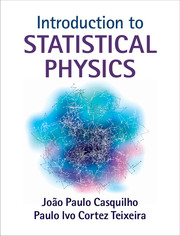Book contents
- Frontmatter
- Dedication
- Contents
- Preface
- Acknowledgements
- 1 Random walks
- 2 Review of thermodynamics
- 3 The postulates of statistical physics. Thermodynamic equilibrium
- 4 Statistical thermodynamics: developments and applications
- 5 The classical ideal gas
- 6 The quantum ideal gas
- 7 Magnetism
- 8 The Ising model
- 9 Liquid crystals
- 10 Phase transitions and critical phenomena
- 11 Irreversible processes
- Appendix A Values of some fundamental physical constants
- Appendix B Some useful unit conversions
- Index
- References
9 - Liquid crystals
Published online by Cambridge University Press: 18 December 2014
- Frontmatter
- Dedication
- Contents
- Preface
- Acknowledgements
- 1 Random walks
- 2 Review of thermodynamics
- 3 The postulates of statistical physics. Thermodynamic equilibrium
- 4 Statistical thermodynamics: developments and applications
- 5 The classical ideal gas
- 6 The quantum ideal gas
- 7 Magnetism
- 8 The Ising model
- 9 Liquid crystals
- 10 Phase transitions and critical phenomena
- 11 Irreversible processes
- Appendix A Values of some fundamental physical constants
- Appendix B Some useful unit conversions
- Index
- References
Summary
Generalities
Most solids are positionally ordered in three dimensions: if the position of one of their constituent particles is known, then the positions of all the other particles will also be known. Particle positions are said to be correlated, and solids possessing this property are termed crystalline. On the other hand, most liquids are positionally disordered: knowledge of the position of one particular particle tells us nothing about the positions of any other particles that are not its near neighbours, as these positions continually change. In this case particle positions are said to be uncorrelated, and liquids possessing this property are termed isotropic. If, however, the constituent particles are markedly non-spherical, they may be orientationally ordered, if their orientations, rather than their positions, are correlated. Materials made up of non-spherical particles may therefore exhibit liquid crystalline phases or mesophases: states of matter in which particles are on average parallel to one another, but where their positions are uncorrelated in one, two or three dimensions. These phases are intermediate between the crystalline solid (which is positionally as well as orientationally ordered) and the isotropic liquid (which is positionally as well as orientationally disordered). A material or substance that exhibits mesophases is called a mesogen.
Liquid crystals were first discovered by the Austrian biochemist Friedrich Reinitzer (1858–1927). In 1888, while studying cholesterol derivatives extracted from carrots, he was surprised to observe that cholesteryl benzoate appeared to have two melting points. Between the solid and the liquid there was a turbid liquid phase. Reinitzer sent some of his samples to the German physicist Otto Lehmann (1855–1922), who examined them using his microscope fitted with light polarisers and a hot stage. Lehmann found that the turbid liquid phase was homogeneous, but had the optical properties of a crystal when illuminated with polarised light. This is how the name ‘liquid crystal’ eventually came to be applied to this class of materials.
- Type
- Chapter
- Information
- Introduction to Statistical Physics , pp. 239 - 268Publisher: Cambridge University PressPrint publication year: 2014
References
- 1
- Cited by

